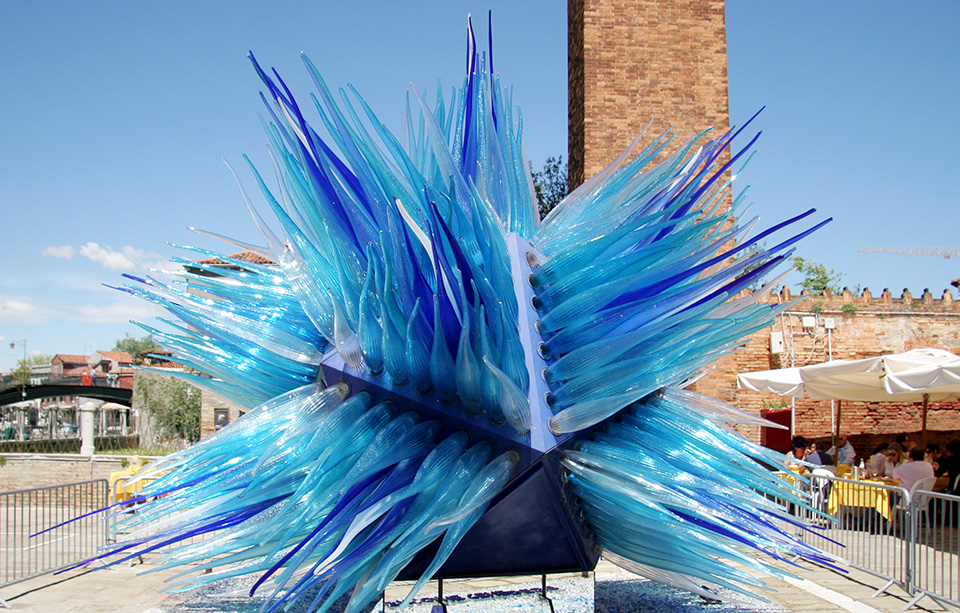The Venice Murano Glass is a type of glass object made in Venice, primarily on the island of Murano. It is world-renowned for being colourful, elaborate, and skillfully made.
Many of the important characteristics of these objects had been developed by the thirteenth century. Toward the end of that century, the centre of the Venetian glass industry moved to Murano.
Byzantine craftsmen played an important role in the development of Venetian glass, an art form for which the city is well-known. When Constantinople was sacked by the Fourth Crusade in 1204, some fleeing artisans came to Venice. This happened again when the Ottomans took Constantinople in 1453, supplying Venice with still more glassworkers. By the sixteenth century, Venetian artisans had gained even greater control over the colour and transparency of their glass, and had mastered a variety of decorative techniques.
Despite efforts to keep Venetian glassmaking techniques within Venice, they became known elsewhere, and Venetian-style glassware was produced in other Italian cities and other countries of Europe.
Some of the most important brands of glass in the world today, including Venini, Barovier & Toso, Pauly and Seguso, are still produced in the historical glass factories on Murano. Barovier & Toso is considered to be one of the 100 oldest companies in continuous operation in the world, having been founded in 1295.

History of Murano Glassmaking
Murano’s reputation as a centre for glassmaking was born when the Venetian Republic, fearing fire and destruction to the city’s mostly wood buildings, ordered the destruction of all the foundries within the city in 1291. Though the Republic ordered the destruction of the foundries, it authorised and encouraged construction outside the city, and by the late 13th century, the glassmaking industry was centred in Murano. Murano glass is still interwoven with Venetian glass.
Murano's glassmakers were soon the island’s most prominent citizens. By the 14th century, glassmakers were allowed to wear swords, enjoyed immunity from prosecution by the Venetian state and found their daughters married into Venice’s most affluent families. Of course there was a catch: Glassmakers were not allowed to leave the Republic. Many craftsmen took this risk, however, and set up glass furnaces in surrounding cities and as far afield as England and the Netherlands.
Murano’s glassmakers held a monopoly on quality glassmaking for centuries, developing or refining many technologies including crystalline glass, enameled glass (smalto), glass with threads of gold (aventurine), multicoloured glass (millefiori), milk glass (lattimo), and imitation gemstones made of glass. Today, the artisans of Murano are still employing these centuries-old techniques, crafting everything from contemporary art glass and glass jewelry to Murano glass chandeliers and wine stoppers.
Today, Murano is home to the Museo Vetrario or Glass Museum in the Palazzo Giustinian, which holds displays on the history of glassmaking, as well as glass samples ranging from Egyptian times through the present day.
The Art of Glassmaking
The process of making Murano glass is rather complex. The glass is made from silica, which becomes liquid at high temperatures. As the glass passes from a liquid to a solid state, there is an interval when the glass is soft before it hardens completely. This is when the glass-master can shape the material.
Materials
The other raw materials, called fluxes or melting agents, allow the glass to soften at lower temperatures. The more sodium oxide present in the glass, the slower it solidifies. This is important for hand-working because it allows the glassmaker more time to shape the material. The various raw materials an artisan might add to a glass mixture are sodium (to reduce melting temperature), nitrate and arsenic (to eliminate bubbles) and colouring or opacifying substances.
Colours, techniques and materials
Colours, techniques and materials vary depending upon the look a glassmaker is trying to achieve. Aquamarine is created through the use of copper and cobalt compounds, whereas ruby red uses a gold solution as a colouring agent. Murrine technique begins with the layering of coloured liquid glass, which is then stretched into long rods called canes (caneworking). When cold, these canes are then sliced in cross-section, which has the layered pattern. The better-known term millefiori is a style of murrine that is defined by each layer of molten colour being shaped by a mold into a star, then cooled and layered again. When sliced, this type of murrine has many points, thus mille (thousand) fiori (flowers). Filigree (a type of caneworking), incalmo, enamel painted, glass engraving, gold engraving, lattimo, ribbed glass and submersion are just a few of the other techniques a glassmaker can employ.
Tools
Murano artisans use specialised tools in the making of their glass. Some of these tools include borselle (tongs or pliers used to hand-form the red-hot glass), canna da soffio (blowing pipe), pontello (an iron rod to which the craftsman attaches the glass after blowing to add final touches), scagno (the glass-master's work bench) and tagianti (large glass-cutting clippers).




